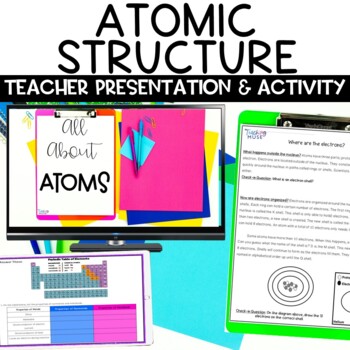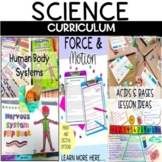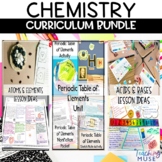Atoms and Atomic Structure Activity
- PDF
- Google Apps™

Also included in
- Teach students about atoms and elements using these print and digital activities. Students will learn about the parts of an atom ( proton, neutron, electron, and nucleus ) and elements through print, digital, and hands on activities. This atoms and elements unit includes activities to bring abstractPrice $15.40Original Price $19.25Save $3.85
- Looking for a science curriculum to last all school year that will help you teach your physical science, life science, Earth science, and chemistry units? Check out everything this science curriculum has to offer. This year-long science curriculum includes science texts, hands-on activities, classroPrice $326.71Original Price $363.01Save $36.30
- Teach your students about chemistry using these materials that will allow students to read to learn about chemistry concepts and practice what they learned. This Chemistry Bundle includes states of matter, physical and chemical changes, atoms, elements, and the periodic table. This chemistry bundlePrice $100.60Original Price $125.75Save $25.15
Description
Teach your students about atomic structure, parts of an atom, atomic number, and atomic mass using these print and digital activities. This lesson will teach students about the parts of an atom; nucleus, protons, neutrons, electrons, and their charges. Students will also learn about atomic theory and how the structure of an atom changed over time. Finally, students will learn how to count atoms to find atomic numbers and mass.
Students will learn:
- What atoms are
- Atomic theory and how the look of an atom changed over time
- Atomic structure: parts of the atom and their charges; electrons, protons, and neutrons
- Where electrons are found
- Atomic number
- Atomic mass
This atoms activity includes:
- Sneak Peek into My Classroom: Read about how I use this lesson in my classroom.
- Teacher presentation - Display the teacher presentation on your Smartboard to have a classroom discussion about concepts related to atoms and atomic structure. The teacher presentation is 18 Google Slides. Teacher presentation includes essential vocabulary terms, science concepts, and comprehension activities.
- Student Note Activity - While learning about atomic structure, students will complete fill-in notes to document their learning. The student note sheet consists of 6 printable pages and follows the teacher's presentation. In addition, this packet can serve as a review for an upcoming assessment.
- Printable Worksheets: 15 pages of worksheets to use with your students. It is broken down into the following:
- What are Atoms? - 3 pages - This packet gives a brief overview of what atoms are, their size, a very brief history of atomic theory, and how atoms react in a chemical reaction.
- Atomic Theory - 4 pages - These worksheets will inform students of the different scientists to study atomic structure, such as Democritus, Dalton, Thomson, Bohr, and Chadwick. In addition, students will learn how they developed and revised the look of the atom over time.
- What are Atoms Made Of? - 2 pages - This section details atomic structure and the parts of an atom and their charges; proton, neutron, and electron.
- Where are Electrons? - 3 pages - Students will learn more about electrons, where they are, their charge, and how they are arranged around the nucleus.
- Atomic Number - 2 pages - These worksheets detail atomic number, finding it by counting the number of protons and why it is important. (This is also a freebie in my store!!)
- What is Atomic Mass? - 2 pages - Informs students what atomic mass is and how to find it by counting the number of protons and neutrons in the nucleus.
- Each reading selection will include essential information students need to know, checkpoint questions for each section, and overall comprehension questions.
- Student Google Slide Activity: Have students work independently to learn about atomic structure using the student digital activity. Students will read and complete activities based on their understanding of the science text.
- Graphic Organizers - Students will summarize and demonstrate their knowledge of atomic theory, atomic number, and mass.
- Review worksheets - 3 worksheets are included to help students practice finding the atomic number or atomic mass of an atom.
- An answer key is always included!
How to use this activity in your classroom:
- Introduce atoms and atomic structure to your students through the reading of the science text. Students will learn how to count atoms, atomic number, and atomic mass, which will help them develop the foundation for your atoms and elements unit.
- Introduce students to important concepts related to the parts of an atom through the teacher presentation.
- Use the science text as homework assignments to reinforce concepts relating to atoms.
- Assign the Student Readings as sub plans when you cannot be in the classroom.
- Use the science text as a science station to review knowledge of atoms and elements.
- Integrate reading skills into your science unit by having students highlight, underline and answer questions using the science text.
Check out the feedback from teachers:
- Great way to incorporate reading with my science. Thank you!
- Lots and Lots of information about atoms in a very sophisticated format. Good practice materials also, and I love the "What did you learn" sections!!
- So great for my special ed students. Thank you.
- Great set, the fill in the blanks provided a great study guide for a follow up assessment.
- LOVE this! I used this as homework and as bell work, and it was wonderful!
Other lessons and activities to support your atoms and elements unit:
Kindly Note: If you have questions, do not hesitate in emailing me at Teaching Muse Email
PLEASE PREVIEW BEFORE PURCHASING
____________________________________________________________________________________
Thank you for visiting Teaching Muse. I would love for you to become a follower.
Teaching Muse followers receive new product information and discounts on any new items!
____________________________________________________________________________________
All rights reserved by Teaching Muse. This product is to be used by the original downloader ONLY. Copying for more than one teacher, classroom, department, school, or school system is prohibited. Additionally, this product may not be distributed or displayed digitally for public view. Failure to comply is a copyright infringement and violates the Digital Millennium Copyright Act (DMCA). They are intended for classroom and personal use ONLY.








